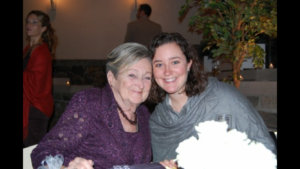March 8th, 2017
Planning for End-of-Life Care: Patients and Providers Working Together
Elizabeth Donahue, RN, MSN, NP-C
I was sitting alone in a parking lot last Tuesday, waiting to meet one of my undergraduate students and her nursing preceptor for a hospice home visit. Little did I know, sitting there in my car, that I would not make it to that visit; instead I was redirected by a phone call to the home of a different hospice patient. My grandmother had passed just a few minutes earlier, under the care and watch of another hospice team and several family members.
Since that Tuesday, I’ve been thinking a lot about the experience of my Nina – her life, of course, but even more so, her death. She lived on her own terms, and I believe that due to a very dedicated care team and the involvement of family members, she was able to die on her own terms as well.
In my role as a clinical instructor, I have learned much from watching my nursing students shadow hospice nurses during the past 3 years. Some lessons: First, you never know what to expect when you enter a patient’s home. Second, time and a listening ear are sometimes the most impactful nursing interventions. Third, serious illness brings a significant range of emotions and reactions from both patients and families. Fourth, conversations about end of life are shockingly infrequent, even in elderly and ill patients.
Getting into that last point, roughly 70% of Americans do not have a health care proxy, mostly due to a lack of awareness of tools and options. This dearth of planning might be easily overcome by increased provider-led conversations. The literature reveals the following: lack of awareness is the most significant barrier; providers can complete forms during office visits; and most people would decline significant lifesaving intervention, thereby saving significant medical costs and emotional trauma for themselves and their families.
As a result, I’ve recently begun to think about having these discussions with some patients in my ambulatory clinic setting, especially because the topic keeps coming up. For instance, over the summer, our office operationalized a workflow for Medicare patients’ annual visits that includes asking a patient if she has a health care proxy, providing her with a form, and offering to witness the form and put it in her electronic medical record. A health care proxy is a basic tool that allows patients to select a delegate empowered to make medical decisions on their behalf if they were to become incapacitated. It is also the beginning of a conversation for patients and providers and, moreover, opens the door to important conversations between patients and those selected as proxies.
In December, a friend forwarded me an article from the Harvard Business Review about conversations between patients and providers about death. I found myself nodding in agreement with this excerpt: “We launched the program in primary care settings, where we guessed that doctors’ long-term and trusting relationships with their patients would ease these conversations.” I thought, yes! I had already found this to be the case when discussing health care proxies with patients. I was sure I could talk about MOLST (Medical Orders for Life Sustaining Treatment) forms, values, and wishes more comfortably than a registrar at the emergency department or a nurse in the ICU could. I was sure I could gently suggest that a spouse, partner, or child who was already looped into medical decisions could share in this process. I wanted to make an effort but was left with questions about how to do it: With which patients? Where should I start? How could I work this into my already busy patient visits?
Lo and behold, a few weeks ago, one of the authors of the HBR article walked into my office conference room to talk about his program with my primary care colleagues. Dr. Lakin made recommendations about how to approach the end-of-life care planning conversation with patients, how to integrate documentation into our records, and even how to bill for such efforts. He shared that, in his experience, relatively few patients (sometimes only a handful out of a panel of hundreds) are approached by their primary care providers for this discussion. It struck me in that moment that we have an opportunity to do so much better, for the sake of our patients and their families.
And the consequences are real. A hospice nurse recently shared with me the heartbreaking story of a patient in her care who had an unclear intent for end-of-life care. Her family had not communicated well and were in disagreement. The patient began to decline rapidly and in the absence of advanced directives or a clear proxy, an ambulance was called. Despite having talked with her nurse about her wish to end her life at home without heroic measures or intervention, the woman passed away in the hallway of a hospital waiting to be triaged.
As for my grandmother, I am immeasurably grateful to her primary care team. She had a nurse practitioner of whom she spoke highly, who ensured she had the care she needed and worked with her hospice team directly (and who called the day she passed, which meant so much to her family caregivers). I was not with my grandmother when she passed away, but because of conversations about end of life and advance-care planning, we had the opportunity to gather around her in her home, to bring her children, grandchildren and great-grandchildren around for one last party, sharing memories and prayers. It was clear to me (and to anyone who knew my grandmother) that this was what was important to her. It was what she had chosen; it was her last act as a matriarch to make her own decisions about her death, to take the burden from her family. In the end, those who were there tell me it was the hospice team that eased her burden, making her comfortable and giving those around her permission to let go. If I could give one patient, one family, that gift, it would be my honor.
Resources
Info for Massachusetts families and providers:
Information and links from the Centers for Disease Control (National):
https://www.cdc.gov/aging/advancecareplanning/index.htm
Articles about advance directives in the health care literature:
http://www.nejm.org/doi/pdf/10.1056/NEJM199103283241305
http://www.ajpmonline.org/article/S0749-3797(13)00521-7/fulltext
http://www.amjmed.com/article/S0002-9343(04)00345-6/fulltext





This is a very thoughtful piece and a call to action to all of us who care for patients in a holistic way. There can’t be enough of these “human” clinical practice guideline articles.It helps all of us to begin to see this conversation as necessary to include in our assessments as ROS,PE and Impressions. Thanks for the insights.
Beautifully written; well-spoken.
A very important topic and a well written article. As a family physician, I have had countless conversations over the years including ones with patients just over 18 years old about the importance of a healthcare proxy. This helps normalize the discussion for them over time which helps both the patient and the health care provider a great deal.